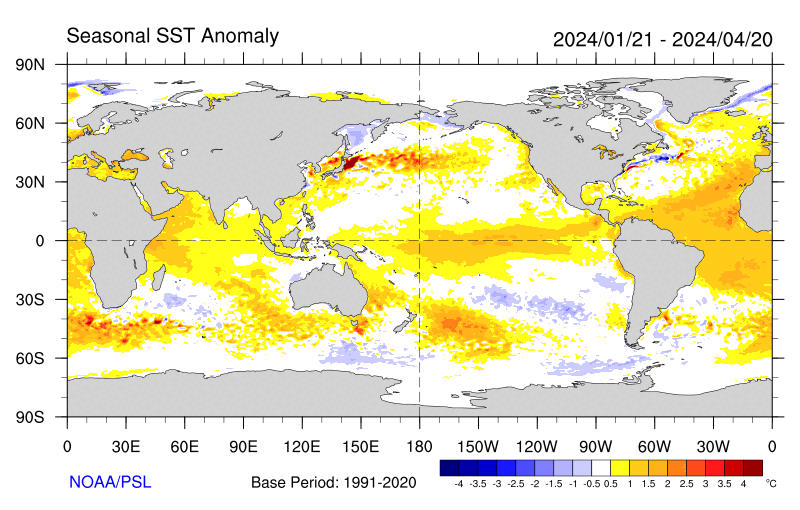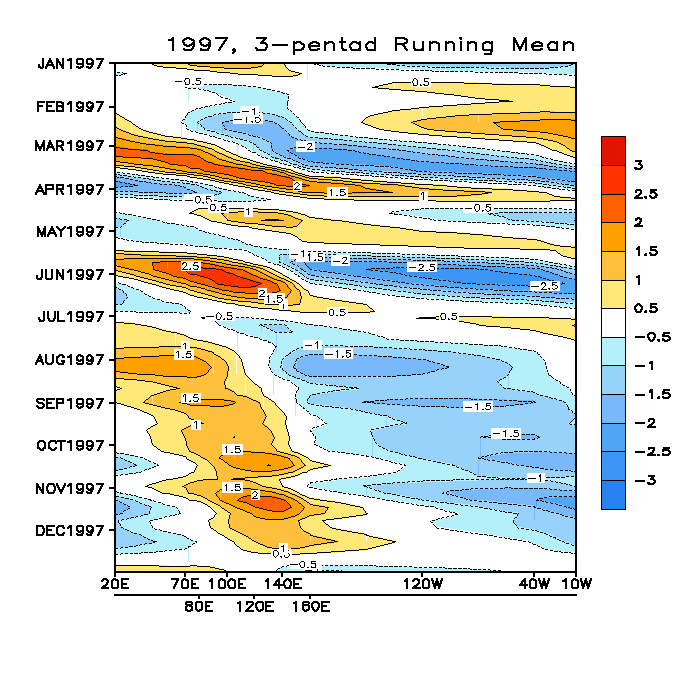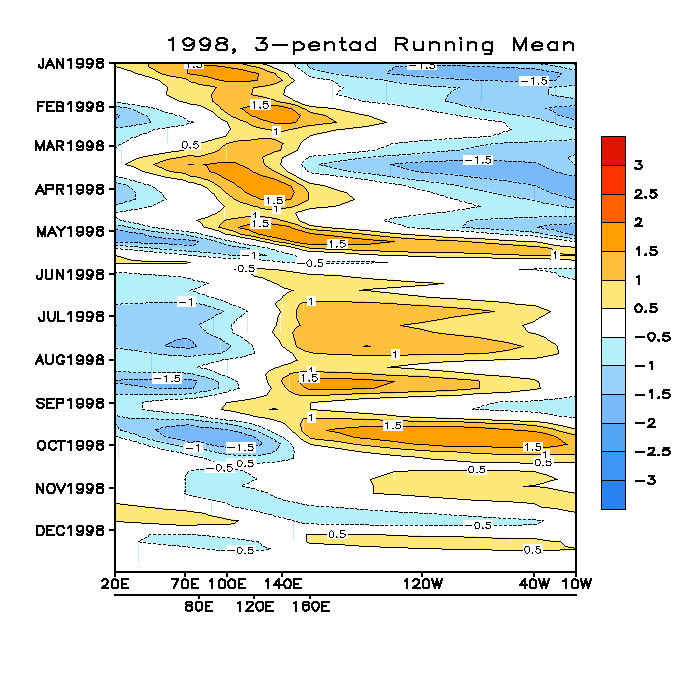a comprehensive data-set of QBO indices back to 1948 can be obtained through the CDC (Climate Diagnostics Center) by using the link below:
http://www.cdc.noaa.gov/Correlation/qbo.data
so what impact will this have on us here in the CONUS:
As most of you are aware...the large scale pattern has in many respects reflected that of what is normal for La nina (cold phase ENSO conditions) of late. this in spite of the fact that equatorial PAC SSTA anomalies have been near to slightly WARMER than avg (coinciding with warm phase ENSO conditions) over the past three months:
from left to right:
WEEK/MO/YR...NINO 1+2...NINO 3.0...NINO 3.4...NINO 4.0
01OCT2003 20.1 -.7 25.3 .4 27.3 .6 29.1 .7
08OCT2003 20.9 .1 25.5 .6 27.4 .8 29.1 .7
15OCT2003 20.9 .0 25.2 .3 27.1 .5 29.1 .7
22OCT2003 21.5 .5 25.3 .3 27.1 .5 29.3 .9
29OCT2003 21.4 .2 25.4 .5 27.2 .6 29.3 1.0
05NOV2003 21.6 .2 25.3 .4 27.0 .5 29.4 1.0
12NOV2003 21.8 .3 25.3 .4 26.9 .4 29.3 1.0
19NOV2003 22.0 .2 25.4 .5 27.1 .5 29.3 1.0
26NOV2003 22.3 .3 25.5 .5 27.2 .7 29.2 .9
03DEC2003 22.5 .1 25.6 .6 27.1 .6 29.2 .9
10DEC2003 22.9 .3 25.5 .4 27.0 .5 29.1 .9
17DEC2003 23.0 .1 25.4 .3 26.8 .4 29.0 .7
24DEC2003 23.0 -.2 25.6 .4 26.8 .3 28.9 .6
the data-set above of weekely averaged SSTA anomalies over the Equatorial PAC nino regions throughout the three month period (OCT-DEC) shows that ONLY the ENSO 1+2 region has seen SSTA anomalies below average during that period. the other three ENSO regions have been consistently ABOVE normal (between +0.3C to +0.6C in the ENSO 3.0 region...+0.3C to +0.8C in the NINO 3.4 region and between +0.6C and +1.0C in the ENSO 4.0 region closest to the dateline).
link to the complete dataset back to 1992...
ftp://ftpprd.ncep.noaa.gov/pub/cpc/wd52 ... /wksst.for
Here is a graphical representation of seasonally averaged SSTA anomalies: (10/5/03 to 1/3/04)

Notice how SSTA over the equatorial PAC have been near to slightly warmer than normal. the greatest area of above normal SSTA to be found was located to the west of the dateline in the NINO 4.0 region.
Also we noticed a strong positive (monthly avg) SOI develop in DEC which bucked the trend of the previous 22 months (remember that the SOI is related to the difference in pressure between tahiti and darwin Australia --- POS SOI would imply that pressues are above normal at tahiti and below normal in darwin australia). the POS SOI and its effect on the downstream pattern is most consistent with that of La Nina whereas the negative phase of the SOI is correlated more strongly to El nino.
the figure below illustrates the connection between the SOI...and pressureas at those two locations:

the negative (east) QBO tends to correlate to an enhanced (and more dominating) PJ as we have been experiencing (while a (west) +QBO implies the opposite).
As the QBO continues to decline...we may be able to expect the PJ to relax as we head into FEB and MAR.
These however are not the only factors responsible for the pattern we are currently dealing with.
the cold pool IF further northeast (like in 2001-02) would imply a presistent RNA Pattern (trough in the west...ridge off the southeast coast of the US)...although since the cold pool is centered further back to the west...its more of a neutral or variable signal . If one was to expect a +PNA to dominate like it did last winter you would want to see a similar SSTA configuration across the north pacific to 1993-94.
Lastly...the more active MJO would be quite consistent with La Nina and ENSO neutral conditions as we have seen (while is less active to in some cases absent in El Nino years).
the correlation between the QBO and the increased POTENTIAL for major east coast snow events is maximized when the upper level zonal winds over the equatorial PAC are near neutral (within +/- 10.00 of neutral).
NINO 3.4 SSTA anomalies over the past three months (between +0.3C to +0.8C) also appear to be quite favorable for major east coast snow events and indeed we have already had two in dec (although DEC 14-15 was a miss for many closer to the coast).
 The posts in this forum are NOT official forecast and should not be used as such. They are just the opinion of the poster and may or may not be backed by sound meteorological data. They are NOT endorsed by any professional institution or
The posts in this forum are NOT official forecast and should not be used as such. They are just the opinion of the poster and may or may not be backed by sound meteorological data. They are NOT endorsed by any professional institution or 








